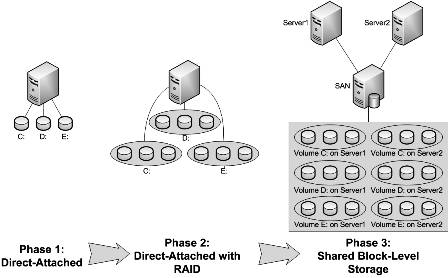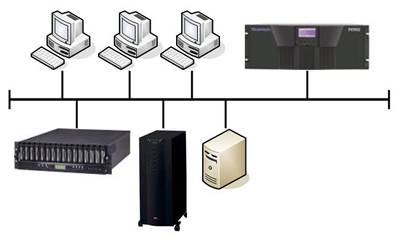
Figure 1: Three configurations for Direct Attached Storage solutions
In this article, I will show you some of the typical storage configurations used for data storage in today's network .
In today's world, everything is almost on the computer. More specifically, everything is stored on the storage device attached to the computer in some configurations. And there are many ways users can access those devices. These access methods have different advantages and disadvantages, so you have to choose which way to suit you. In this article we will give you some ways to access it and describe some solutions where you can implement them.
The first is the architecture called Directly Attached Storage (DAS) . This is what most people often refer to when thinking about storage devices. This type of architecture includes components such as internal hard drives, external hard drives, USB drives. Basically DAS refers to anything that is directly attached to a computer (or server) and not a certain network component (like a switch) between them.

A DAS device can even allow multiple users to access data simultaneously. All that is required is that the device has connectivity ports and is capable of supporting multiple users simultaneously. DAS configurations can also be used in large networks when they are attached to servers that allow multiple users to access DAS devices. The only thing that DAS does not claim is the presence of a carrier between storage devices and computers.
Many home users or small businesses need to configure the Network Attached Storage (NAS). NAS devices provide a convenient way to centrally centralize storage devices, although no need to locate with your computers. This feature is convenient for many home users who want to put their storage devices in a certain location and use them for all computers or laptops in the home. This feature also appeals to small businesses, which are not suitable for investing in large storage devices. DAS configuration can also provide this feature, but not easily implemented in small situations.

NAS devices are basically a truncated computer. Although there are no screens, keyboards, but they do have operating systems that you can configure, connecting to the device is through a web browser from a computer on the network. NAS operating systems are simple versions of UNIX operating systems, such as FreeNAS. FreeNAS supports many file formats, such as CIFS, FTP, NFS, TFTP, AFP, RSYNC and iSCSI.
Since NAS devices manage their file system functions themselves, they don't need to go to the server to perform this function. Networks using DAS devices attached to the server will require the server to manage file system functions. This is a strong point of NAS compared to DAS. The NAS frees the server so you can perform other important processing tasks because the NAS device is directly connected to the network and manages all file operations. This also means that NAS devices will be simpler to configure and maintain for small executable environments because they do not require a dedicated server.
NAS systems often use RAID configurations to provide users with a powerful storage solution. In this perspective, NAS devices can be used like DAS devices (for data backup). The biggest and most important difference between NAS and DAS systems is that NAS systems must include at least one network device between the user and the NAS device.
NAS solutions are the same as other storage configurations called Storage Area Networks (SAN). The biggest difference between a NAS system and a SAN system is that the NAS device manages the operating system's file system functions and the SAN system only provides storage services by block and to system functions. The file is executed by the client computer.
That does not mean that NAS cannot be combined with SANs. In fact, large networks often use SANs with NAS to meet the needs of their users.
One advantage that SAN systems are superior to NAS is that NAS systems cannot be easily expanded. SAN systems can easily add servers in a cluster to manage more users. NAS systems used in fast-growing networks are often unable to manage increased traffic, even if they can manage storage capacity.
This does not mean that NAS systems are not expandable. In fact, it is possible to group NAS devices in a similar way to grouping servers in a SAN system. Doing this will allow you to access from any node in the SAN group. But what may not mean what should be done; You should choose the best SAN enforcement solution in this situation.
Even so, NAS systems are less expensive than SAN systems and in recent years NAS manufacturers have focused to expand their presence on home networks where many people Use high storage demand for multimedia files. For most home users, a system that is less expensive and does not require servers and physical space to set up storage devices will certainly be a more attractive solution than the SAN configuration.
SAN systems also have many advantages over NAS systems. For example, it allows to easily replace a faulty server in a SAN system, while it is difficult to replace a NAS device whether or not it is clustered with other NAS devices. In addition, it is also much easier to geographically distribute arrays within a SAN system. This type of geographic distribution is often very valuable in the prevention and disaster recovery.
The biggest advantage of SAN systems is that they provide simple management, high scalability, flexibility, improved data backup and access. For this reason, SAN configurations are becoming more popular for large businesses that really care about data storage.
In addition to large networks, SAN configurations are not commonly used. An exception to this is that in the area of video editing requires a high capacity storage environment along with a large bandwidth to access data. A SAN configuration using Fiber Channel is really the best solution for video editing networks and networks in similar areas.
Each of the three configurations listed in the article (DAS, NAS and SAN) has its advantages and disadvantages. Investing thinking to find the right network design will save a lot of effort when developing the network or when you need to upgrade different aspects of the network. Therefore, selecting the configuration is important, your task is to choose which configuration is suitable for the current needs and the needs that are expected in the near future to the medium future.
